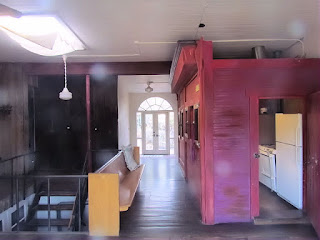Tracks Towns Vintage
Trolleys: Illustrated Articles
The Tucson
Street Rail
Road
The Elysian Grove
Historic
Travelling the Old Camino
Real, (Royal Road Rosendo
S. Perez Park, today you will find
several Placards relating the significance of the Neighborhood and the Park, in
English and Spanish.
The Placard above reads: “Mule
Drawn Trolley July 1904”
“As you look East on Simpson toward Meyer, you can
imagine the mule drawn trolley turning the corner to bring Tucson citizens to
Elysian Grove for a barbeque, a dog race, an air show, or a picnic in the park.
On weekends that trolley would make the turn from
Meyer onto the spur at Simpson and come 600 feet to deliver passengers to The
Grove.”
Weekends at The Grove
Tucson
 |
Above: Carrillo Elementary, May 2013, located at the Corner of South Main and Simpson, Site of Carrillo’s Gardens, 1878-1903, and the Elysian Grove 1903-1921. Photo Courtesy LensandPens, |
Weekends at The Grove
The Grove, some 25 Acres in
all, would have been the favorite local Tucson Lake and a Skating Rink, would have attracted visitors by
the thousands.
The
Trolleys, Urban Mass-transit of the day, afforded Citizens and Tourists easy access
the Grove from various parts of Tucson, and points far beyond.
 |
Above: Interior Elysian Grove Market. Photo Courtesy LensandPens, |
Elysian Grove,
1903-1921, formerly Carrillo’s Gardens, 1878-1903.
Click to learn more: http://www.sandario.com/walking_elysian.pdf
 |
Above: Elysian Grove Market, Corner of West Simpson and Sanmaniego, May 2013. Photo Courtesy LensandPens, |
Trolley Service to The Grove
“One of the reasons for the declining patronage
starting in August of 1904 was the company's failure to provide the announced
and promised 15 minute service on a consistent basis. The partial record of the
daily usage of the cars reveals that utilization was sporadic. The public
simply couldn't, on any given day, know how many cars would be running. For
example in the 11 months between mid-August of 1903 and mid-July of 1904, the
four required cars were operated on only 144 days, or 43% of the time.”
“One thing is clear. The problem continued beyond the
point for which we have records. The Citizen for January 27, 1905,
quoted Hoff as saying,
‘The trouble with the corporation is that it has been
losing money lately, and as a matter of fact I have had to go out and borrow
money to the extent of $3000 by selling some of my own property, and otherwise
getting coin in order to carry things along. . . During the last two months our
receipts have only been about $6 per day, and our expenses are about $16 daily,
so you see that we are not making any very big money at that rate.’
The Tucson
"The service of the Tucson street
Click to learn more: http://parentseyes.arizona.edu/hooves/
Draft Animals to Modern Electric Power
From its inception in 1897,
the Tucson Street Railway played a crucial role, transporting Riders and their
goods, to and from shops, and connecting the dusty frontier village of Tucson
with the Southern Pacific Rail Line; and El Paso to the East, and Los Angeles
to the West.
As progress and growing popularity
placed increasing demands on the Street Railway, unreliability became the focus
of Street Rail woes in the early 1900s, and Time was running out for Trolley
Power by Draft Animal.
Reading from the Pages of
Hooves & Rails...
“On June 1, 1906, the symbolic last horsecar and two
electric cars proceeded from Stone and Congress to the carbarn on the northeast
corner of Stone and Fifth Street
The last reminder of theTucson Street
New Gates and New Trolleys
Tucson

The last reminder of the
 |
Above: A Tucson Street Rail Stock Certificate owned by Louise Foucar, Wife of Tom Marshall, purchased in October 1903. Photo Courtesy Through Our Parents Eyes / The University Neighborhood. |
Reading from the Pages of
Through Our Parents Eyes / The University Neighborhood...
“Louise Foucar bought three shares for three hundred
dollars in the Tucson Street West
University
Click to learn more: http://parentseyes.arizona.edu/univneighborhood/newgate.htm
 |
Above: The Car Barn at Photo Courtesy |
Originally, the Tucson Rapid
Transit Company, with an initial fleet of only Two Electric Streetcars in 1906,
connected the fledgling, and otherwise isolated, University of Arizona
Click to learn more: http://parentseyes.arizona.edu/univneighborhood/newgate.htm
Tucson Rapid Transit Company: The First Electric
Streetcars
Reading from the Pages of Old
Pueblo Trolley Transit History Home Page...
“From 1898 to
1900 TSR ran a line from the Southern Pacific depot to the University of
Arizona campus via Congress, Stone and 3rd Streets with a branch line west on
Pennington. Service was expanded between 1902 and 1904 to include an extension
along the north side of the University of Arizona and additional routes south
of downtown including to Elysian Grove which was a 25 acre park noted for its
floral displays, amusement park and man made lake.
A 1904 TSR report showed an inventory of seven cars, 8
1/4 miles of track and 34 head of livestock. Horse cars ran in Tucson
Tucson Street Railway became Tucson Rapid Transit
Company in June of 1905, a name which would be maintained in Tucson Los Angeles Tucson
Click to learn more: http://www.oldpueblotrolley.org/transhist.htm
Two Man Electric Tucson
Click to learn
more:








No comments:
Post a Comment